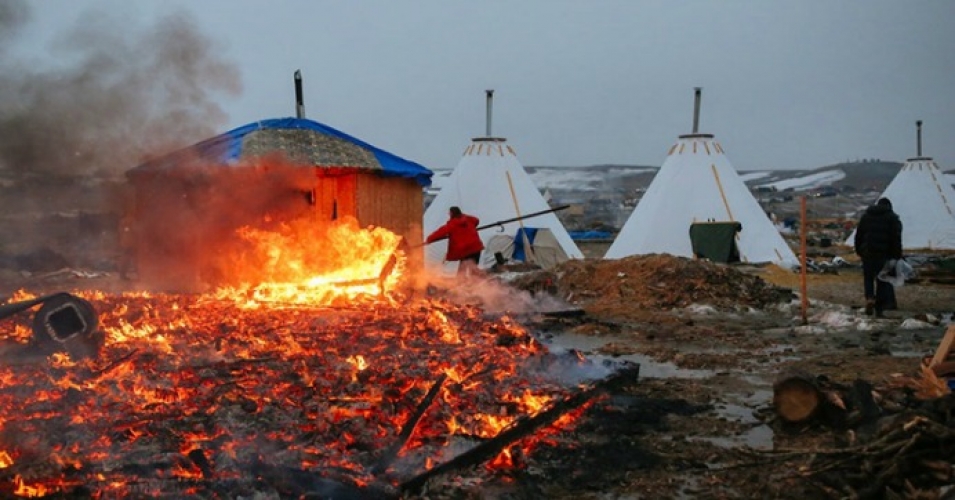
As fate would have it, the pilgrimage’s odyssey across Turtle Island first began as a one year sojourn among the Hunkpatina people on the Crow Creek Sioux Reservation, located near the Big Bend of the Missouri River at Fort Thompson, South Dakota.
The Hunkpatina at Crow Creek were the descendants of Chief Long Crow and his people who had been transported against their will from their earlier homelands in Minnesota following the Dakota peoples Mankato Uprising of 1862 that was waged against the U.S. Government and invading immigrant farmers who had stolen their lands and were utterly destroying the Hunkpatina culture and way of life. Crow Creek, aside from having the notorious distinction of being the site of South Dakota’s worst massacre of some 500 Arikara people in 1325, became a virtual prisoner-of-war camp. By the time I arrived, their reservation’s more recent school, hospital, burial grounds, farm gardens and Missouri bottomland homes had all been either physically destroyed or drowned by an Army Corp of Engineer dam. Over the years since, Crow Creek and its Buffalo County surrounds have been among the poorest, if not the poorest place in America, with unemployment often raging upwards of 80%. Witnessing the living native spirit of the Crow Creek people began as a love affair with the Missouri River or Mni-sose (Minneshoshay, ‘Muddy River’) as it’s referred to in the region’s native Siouan dialect.
Even from the window of a jetliner at 30,000 feet, that first hazy glimpse through the clouds at the ‘Big Muddy’, the world’s second longest river, was like coming into the presence of a wise, venerated sage. As the jet swooped down to make its final gliding approach to Pierre, dipping one wing low over Mni-sose, I caught an eagle’s-eye view of a scene that could have jumped right off a 19th century George Caleb Bingham canvas. There, in a quick brushstroke of my eyes, lay the sparkling Missouri, framed by lazy Cottonwoods draped in dewy-morning air, as an Indian man and young boy with long braids paddled their canoe.
It wasn’t long after arriving that I met up with one old Crow Creek elder who at once dubbed me – Jerry Vista – because I was coming to him as a Vista Volunteer who was then engaged in the War Against Poverty. “Jerry Vista”, he quipped, “Your White Man’s teachin’ books got it all wrong! ‘Cause it’s Mni-sose, not the Mississippi, that flows in tah th’ Gulf of Mexico. Tell ’em it’s just ’cause they saw th’ Mississippi first that made ’em get it all back-asswards! HE! HE! HE!
As his chuckle trailed off into a low murmur, the elder – tapping two fingers in the palm of his hand as if they were a drumstick softly beating a drum – began to sing an old Dacotah Water Blessing song. Before even realizing it, I joined in, humming under my breath the chant spontaneously made to the Mighty Missouri upon first spying her 4,000-mile long, muddy-brown, serpentine body through that lofty stratosphere portal.
With our eyes fixed upon Mni-sose in the distance, the elder’s blessing and my impromptu chant – laced with elements of an immigrant Irish grandfather’s once hopeful ‘Shenandoah’ hymn – slowly melded. In an instant, the body, mind and soul’s of an old Dacotah Indian and one young Irish-Tyrolean Celt fused into one sweet, sonorous song of love.
All at once, my senses were caught up in an intense affair with the shifting moods of Indian Summer light and smells that played upon the plains and prairies paralleling Mni-sose on its western and eastern banks. Subtle shades and sweet scents highlighted the magical spectacle of the land’s great physical expanses as huge, bilious, cloud-filled skies splayed out from her in all directions, from horizon to horizon; this palette of Mother Nature’s chiaroscuro enhanced by the romantic hues and changing dispensations of those first sun-filled autumn days and night-time moons.
Setting out alone on still, luminescent, moonlit nights, I walked for miles as if in a somnambulistic trance, plying prairies and plains high above Mni-sose, mesmerized by the thoughts of those unknown legions of past generations and the rich legacies they embodied who once passed along this same sinuous waterway.
For hours on end, I just sat as if a daze, upon a high bank under the blazing-hot sun, hypnotically staring out across the wide Missouri as its slow-moving eternal waters boiled and churned up great, surging whirlpools of rich Dakota silt, moving ever southward towards some unknown distant place of rest. At one point, with paper and pen in hand, out-flowed a poem:
– IN THE SPAN OF A HEARTBEAT –
Once Upon A Time –
While gazing longingly
Upon a placid Mni-sose,
Enveloped by warm amber field
Bathed in golden sunlight
Set against a still, crisp,
Crystal-blue Indian Summer day,
A sacred sound was heard.
Its Origin –
The distant thunderous roar
of tens of thousands of Canadian honkers,
Massing overhead,
Like an airborne Niagara Falls.
Their ‘V’ formations
Everywhere emerging upon the horizon
Like ascending, swirling currents
Of feathered wings,
Each seeking
To play their own small part
In drowning out the noon-day sun.
The sheer majesty of their cacophony
eloquently heralding-
“Lad! Look, Listen and Behold!
For Life’s Circle Dance
All Around You
Has Begun Anew!
The Dance –
Turning One More Turn
Upon The Timeless-Spaceless
Medicine Wheel of Creation!”
Having arrived at Crow Creek, I was drawn back to that spot time and again, like an iron filing being drawn to a magnet, just for another chance to quietly sit beneath a new deciduous mentor that had called me to its side. Reveling amidst sweet scents of native buffalo grass, wild grapes, prairie roses and chokecherries, I fitfully tried to imagine the whole gamut and panoply of the human and natural worlds once intertwined there.
Images pondered since youth: of a raucous, lawless, Wild West Leadville, Colorado birthplace; the mysterious cliff-dwellings of the Anazazi of Mesa Verde and even more mysterious Yelamu Indians of San Francisco’s San Bruno Mountains, who had all disappeared with nary a trace; flashed into thought; each image conjuring up yet another unanswered question about the transitory nature of life and why it was that I’d been sent to this lonely Crow Creek place along the Missouri.
“What Answers, Lad, Does Your LIfe Owe Me?”, telepathically asked Mni-sose one day, as I sat staring at her off in the distance. “What answers indeed, Lad!”, cried out The Voice inside, amidst the heralds of ten thousand cicadas, ‘will you learn from the Crow Creek people themselves?”
Author Bio: During the 1960’s and early 70’s Irwin lived with the Dakota and Lakota peoples on the Crow Creek Sioux & Oglala Sioux Reservations in South Dakota and later published the book, “The Wild Gentle Ones; A Turtle island Odyssey” (www.turtle-island-odyssey.com) that documents their historical plight and those of other indigenous peoples on Turtle Island.
*This excerpt is from Volume 1 of the three volume literary project, “The Wild Gentle Ones; A Turtle Island Odyssey” (www.turtle-island-odyssey.com). It’s meant to offer some background to the sacredness of the Missouri River and Water that is one of the focuses of the op-ed, “Wall Street Is Prepared To Destroy Sacred Sioux Indian Burial Grounds”
















































